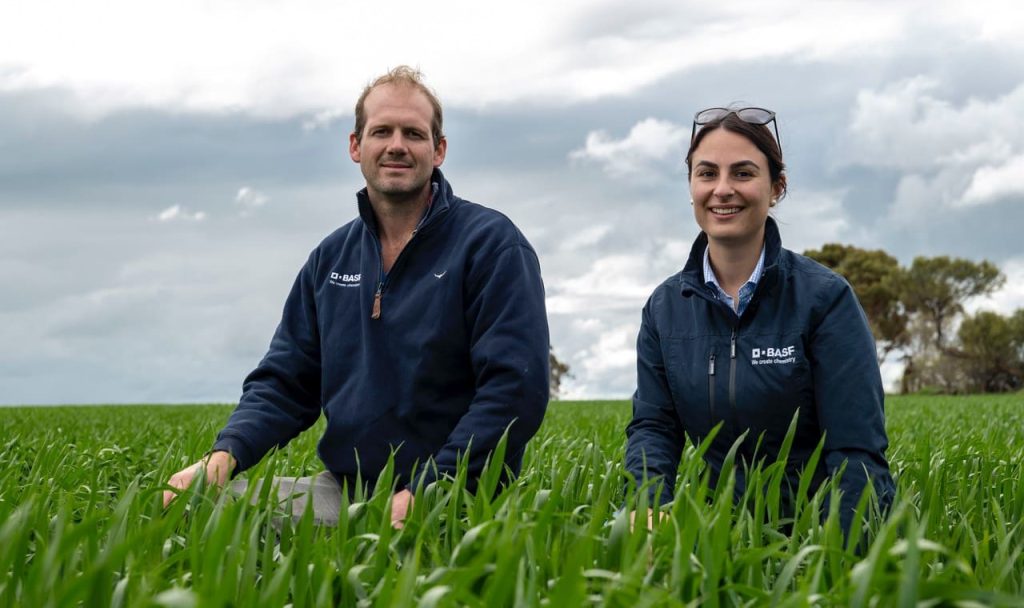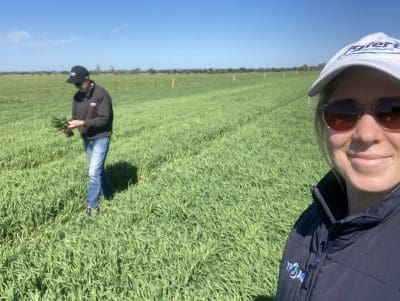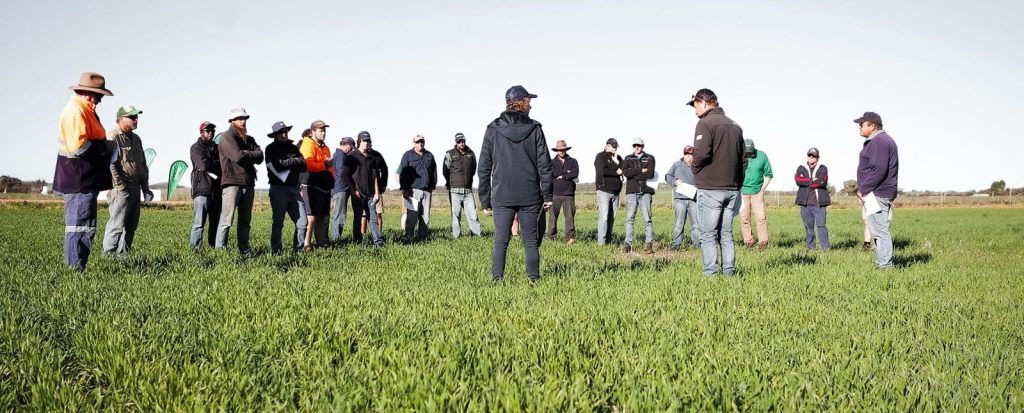
BASF’s broadacre specialist Caroline Dix and Quairading, WA grower Scott Walker in a Luximax protected crop
POST-emergent weed control can be a lot more challenging than pre-emergent control because the target weeds will be at a range of different growth stages and becoming harder to knock down with every day that passes.
Success depends on responding to the challenge as it takes shape: identifying the mix of weeds and growth stages and selecting the right tools to overpower the plants that can be the hardest to control.
It’s that need to react quickly and correctly that makes Frequency Herbicide such a valuable addition to spray programs in wheat, including durum, and barley crops.
Frequency has a unique Group 27 HPPD inhibitor active – topramezone – that can be tank-mixed with either LVE MCPA or bromoxynil. Once you’ve chosen which of the two will be most effective against the particular broadleaf weeds that have emerged, you can choose to use them at a higher rate if the weeds’ growth stage or density requires it.
Adaptability
“Adaptability is such a key to all aspects of farming,” says David Elmouttie, the Head of Broadacre and Horticulture at BASF.
“In recent years we have released a whole range of crop protection products that add flexibility to the program by introducing new modes-of-action and expanding the overall spray rotation. Frequency is something else again. Its point of difference is that you can already have it in the shed but choose at the last minute to make it the base product in any one of many possible tank-mixes.”
Group 27 chemistry is a mainstay of post-emergent spray programs in cereal crops, but the older herbicides were launched as co-formulations that also already included either LVE MCPA or bromoxynil. The two active ingredients in each product were in a fixed ratio that might not turn out to be the most effective combination to control the target weeds in any given situation.
Now growers can set the right mix partner and appropriate ratio to suit the situation and even add both LVE MCPA and bromoxynil to the tank if the size and spectrum of weeds demands it.
Resistance management
Frequency is an advance on older Group 27 herbicides in other ways too. Topramezone is a next-generation HPPD inhibitor that shares the same mode of action as others in the group but works far more efficiently. Frequency’s single approved application rate – 200 mL/ha – delivers just 12 g/ha of topramezone. That very small amount is enough, working with the selected tank-mix partner, to knock down some notoriously hard-to-control broadleaf weeds.
The combination of a low Frequency application rate and the flexibility to adjust the rates of its tank-mix partners helps with resistance management too.
“One of the keys to managing resistance is to use crop protection products very efficiently,” says David.
“The aim is to use as little chemical as possible to achieve very high levels of control. Being able to ‘dial up’ the rates of Frequency’s tank-mix partners to tackle large weeds is very useful, but growers can also save money and avoid overkill by keeping the rates low when the target weeds are smaller or less tricky to control.”
Using a full dose of both Frequency and the mix partner on weeds with a high resistance risk but using the lower label rates when they’re sufficient to get the job done is a very practical and cost-effective application of the WeedSmart principles.
Choosing tank-mix partners
Another way of achieving greater efficiency is to choose the tank-mix partner that’s most effective on the dominant weed or weeds emerging in the crop. Bifora, capeweed and wild radish, for instance, are all more susceptible to bromoxynil than LVE MCPA. Fumitory, on the other hand, is listed on the label for control up to the 6-leaf growth stage using either mix partner but experience has shown that LVE MCPA has the edge over bromoxynil for that particular weed.
“Members of our team are always happy to provide very specific advice about the best mixes and rates to use on various weed infestations,” David says, “but of course there’s already a lot of experience in every cropping area of using Group 27 chemistry with bromoxynil and MCPA and herbicides from other mode of action groups.
experience in every cropping area of using Group 27 chemistry with bromoxynil and MCPA and herbicides from other mode of action groups.
So most growers will have a head start even if they’re using Frequency for the first time and that will allow them to take immediate advantage of the added flexibility.
As always, their agronomists will be able to tell them exactly which tank-mixes other growers in the district have had success with on particular weeds. All of that shared knowledge can help get full value from the extra efficiencies Frequency makes possible.”
Wild oats applications
There’s no doubt that Frequency is primarily a broadleaf herbicide, but trial work while the product was in development showed that it is surprisingly active on a species of wild oats.
In other parts of Australia, farmers mean Avena fatua when they talk about wild oats. But in northern New South Wales and Queensland, Avena sterilis is the dominant species. In those areas, a Frequency and bromoxynil tank-mix is registered to suppress seed-set.
The label advises that Frequency will cause significant bleaching and reduce growth enough to eliminate some plants and significantly reduce the flowering and seed-set of plants that survive. If wild oats pressure is relatively low, that may be sufficient. If wild oats are a major target of the application, a suitable grass herbicide should be included in the tank-mix.
Trials on Avena fatua have shown Frequency has some impact on that species too, but the reduction in seed-set wasn’t consistent enough to warrant a label claim.
“Its registration in wild oats highlights that Frequency is not exactly the same as other Group 27 herbicides,” concludes David “Topramezone is a unique active ingredient with its own particular characteristics. We know it’s more potent than the older actives with the same mode of action and its activity in a grass weed is another point of difference.
“We hope those distinctive attributes will encourage growers and agronomists who haven’t yet tried it to see what it can do – in a range of tank-mixes – to control problem in-crop weeds under their growing conditions.”
Click here for more information on Frequency herbicide.



HAVE YOUR SAY